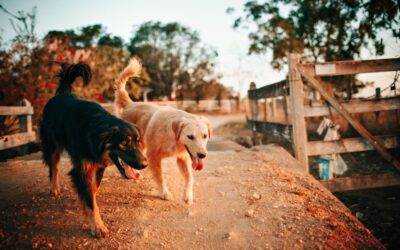Shaking a can with coins is bad for dogs as it can cause anxiety and stress. Dogs have sensitive hearing, and the loud noise can be distressing for them.
- Understanding The Potential Dangers
- Physical And Emotional Consequences For Dogs
- Physical Health Risks For Dogs
- Behavioral Issues Resulting From Shaking Cans
- Alternatives To Shaking Cans With Coins
- Training Dogs Responsibly
- Conclusion: Prioritizing Dogs' Well-Being In Training
- Frequently Asked Questions For Is Shaking A Can With Coins Bad For Dogs
- Conclusion
It is natural for dogs to exhibit some form of curiosity or anxiety when confronted with unexpected loud noises or abrupt movements. While certain sounds may seem harmless to us, they can have a profound impact on our furry companions.
One such concern arises when it comes to shaking a can filled with coins in the proximity of dogs. Although it may be inadvertently done to discipline or deter unwanted behavior, it is important to understand the potential repercussions. We will delve into the effects of shaking a can with coins on dogs, exploring the reasons behind their negative reaction and the potential consequences for their well-being. Dog owners must be aware of how certain actions can affect their beloved pets in order to provide them with a safe and stress-free environment.
Understanding The Potential Dangers
Shaking a can with coins can be dangerous for dogs. The loud noise and sudden movement can startle and distress them, potentially leading to anxiety or injury. It is best to avoid this practice to ensure their safety and well-being.
Shaking Cans Filled With Coins: A Common Training Method
When it comes to dog training, many pet owners turn to various methods to correct unwanted behaviors. One such method is shaking cans filled with coins, which is believed to deter dogs from engaging in certain actions. However, it’s essential to understand the potential dangers associated with this training technique.
In this section, we will explore the impact of noise on a dog’s sensitive hearing, shedding light on why it may not be the best approach for training your furry friend.
The Impact Of The Noise On A Dog’s Sensitive Hearing:
- Excessive noise exposure can cause stress and anxiety in dogs, leading to potential behavioral and health issues.
- Dogs have a much more sensitive hearing range compared to humans. While humans can typically hear sounds up to 20,000 Hz, dogs can detect frequencies as high as 65,000 Hz.
- Shaking cans filled with coins produce a loud and sudden noise that can startle and distress dogs, especially those with noise sensitivity or anxiety disorders.
- The loud noise can potentially cause ear damage to dogs, leading to hearing loss or other hearing impairments.
- Continuous exposure to such loud noises may result in a negative association, causing dogs to develop fear or aggression towards the can or certain environments where the sound is present.
Considering the potential dangers associated with shaking cans filled with coins, it’s essential to explore alternative training methods that focus on positive reinforcement and reward-based techniques. Always prioritize your dog’s well-being by seeking professional advice or consulting with a certified dog trainer who can provide guidance tailored to your pet’s unique needs.
Remember, effective training should aim to create a positive and nurturing environment for your dog to thrive in, improving their behavior without compromising their physical or mental health.
Physical And Emotional Consequences For Dogs
Shaking a can with coins can have both physical and emotional consequences for dogs. It may cause fear, stress, and anxiety in dogs, potentially leading to various behavioral issues and even physical harm. Therefore, it is recommended to avoid using this method as a training technique for dogs.
Dogs have highly sensitive hearing and are easily affected by loud noises. Shaking a can with coins can have several physical and emotional consequences for our furry friends. Let’s take a closer look:
Stress And Anxiety Caused By The Loud Noise:
- Dogs have a natural instinct to react to sudden loud sounds. When a can is shaken with coins, the resulting noise can startle and scare them.
- Dogs may experience increased heart rate, trembling, and even hyperventilation as a result of the stress caused by the loud noise.
- The sudden and unexpected sound can lead to anxiety in dogs, making them feel unsafe in their surroundings.
Potential Hearing Damage And Long-Term Effects:
- Dogs have hearing that is far more sensitive than humans. The loud noise produced by shaking a can with coins can cause temporary or permanent hearing loss in dogs.
- Prolonged exposure to loud noises can also lead to noise phobia in dogs, making them fearful of similar sounds in the future.
- Dogs that are frequently exposed to loud noises may become hyper-vigilant and constantly on edge, increasing their overall stress levels.
In Summary:
The physical and emotional consequences of shaking a can with coins can be detrimental to dogs. The loud noise can cause stress, anxiety, and potential hearing damage. It is important to be mindful of the potential harm it can cause to our furry companions and to find alternative training methods that prioritize their well-being.
Physical Health Risks For Dogs
Shaking a can with coins may pose physical health risks for dogs. The loud noise can startle them, potentially causing anxiety and hearing damage. It is best to avoid using this method for training or disciplining your furry friend.
Shaking a can with coins can pose various physical health risks for dogs. Let’s explore some of the potential dangers:
- Injuries from sudden movements caused by fear or panic: Dogs have sensitive hearing and can become startled by the loud noise of shaking coins. This can lead to sudden movements or actions that may result in injuries. Some potential risks include:
- Sprained limbs or joints: Dogs may twist their limbs or joints while attempting to escape or hide from the perceived threat caused by loud noises.
- Muscle strains: Sudden jerking movements can strain a dog’s muscles, leading to discomfort and potential temporary mobility issues.
- Fractures or broken bones: In extreme cases, dogs may injure themselves by jumping or running in a panicked state, potentially resulting in fractures or broken bones.
- Potential damage to a dog’s delicate ear structure: Dogs’ ears are highly sensitive, and subjecting them to excessive noise can cause harm. Shaking a can with coins can pose risks such as:
- Ear trauma: The loud noise from shaking coins directly next to a dog’s ears can potentially lead to damage to the sensitive structures inside the ear.
- Tinnitus or hearing loss: Repeated exposure to loud noises, like shaking cans with coins, can contribute to long-term hearing issues, such as tinnitus or even partial hearing loss for dogs.
It is important to be mindful of the impact that loud noises, such as shaking cans with coins, can have on a dog’s physical well-being. Taking precautions to protect their delicate ears and ensure their safety should always be a priority.
Behavioral Issues Resulting From Shaking Cans
Shaking a can with coins can lead to behavioral issues in dogs, causing anxiety and fearfulness. The loud noise can startle and traumatize them, resulting in long-lasting effects on their behavior. It is important to avoid this practice to ensure the well-being of your furry companion.
Shaking a can with coins is often used as a training method to discourage dogs from engaging in unwanted behaviors. However, this technique can have unintended consequences and may lead to behavioral issues in dogs. Let’s explore the potential negative effects of shaking cans on canine behavior.
Association Of Negative Experiences With Specific Objects Or Sounds
- Dogs can associate specific objects or sounds with negative experiences. When you shake a can with coins, the noise it produces can startle and potentially scare your dog. This association may lead to an aversion to the sound of shaking cans.
- The dog may start to display fear or anxiety whenever it hears similar sounds, such as keys jingling or rattling sounds. This can create a stressful environment for your furry friend.
Fear And Aggression As A Result Of Conditioning
- Shaking a can with coins can inadvertently condition fear and aggression in dogs. If the dog consistently experiences this negative stimulus whenever it engages in a certain behavior, it may start associating that behavior with the unpleasant shaking sound.
- Over time, the dog may exhibit fear or aggression as a defense mechanism to avoid the negative consequences associated with the sound of shaking cans. This can lead to increased tension and possible aggression towards the owner or other individuals.
How To Mitigate The Negative Effects
- Use positive reinforcement techniques instead of relying solely on negative stimuli. Rewarding your dog for desired behaviors can be more effective in shaping their behavior and fostering a positive bond between you and your furry friend.
- Consult with a professional dog trainer or behaviorist to address any behavioral issues your dog may be exhibiting. They can provide guidance and personalized training plans to address your dog’s specific needs.
- Provide a safe and calming environment for your dog. Creating a secure space where your dog feels comfortable can help reduce anxiety and prevent the development of negative behaviors.
- Regular exercise and mental stimulation are key for a happy and well-behaved dog. Engage in activities that keep your dog physically and mentally active, such as interactive toys, obedience training, and daily walks.
Understanding the potential behavioral issues that can arise from shaking cans with coins is essential for responsible dog ownership. By using positive reinforcement techniques and seeking professional guidance when needed, you can build a trusting relationship with your dog and promote their overall well-being.
Alternatives To Shaking Cans With Coins
Shaking cans with coins may be harmful to dogs. Fortunately, there are alternative methods available to discourage unwanted behavior without putting your furry friend at risk.
Positive reinforcement training techniques:
- Reward-based training: This involves rewarding your dog with treats, praise, or playtime when they exhibit good behavior. By focusing on positive reinforcement, you can encourage your dog to repeat these desired behaviors.
- Clicker training: Using a clicker is an effective way to communicate with your dog. Pairing a distinct clicking sound with rewards helps your dog understand what actions you want them to perform. Clicker training can be used for various commands and tricks.
- Verbal cues and commands: Teaching your dog specific verbal cues and commands allows you to communicate your expectations clearly. Consistency is key when using this training method, reinforcing the behavior with rewards or praise when your dog responds correctly.
Tools and methods for effective dog training without harmful effects:
- Treat dispensing toys: These toys can provide mental stimulation and reward your dog for problem-solving. By filling these toys with treats, you encourage your dog to engage and work for their rewards actively.
- Luring with treats: Using treats as a lure can facilitate desired actions from your dog. By guiding their movements with a treat, you can encourage them to perform commands like sitting or lying down.
- Target training: Involving a target object, such as a stick or cone, can help your dog understand specific positions or actions. By associating the target object with rewards, you can guide your dog’s behavior.
- Puzzle toys: These toys engage your dog’s problem-solving skills while providing mental stimulation. They often involve hiding treats within compartments that your dog has to discover and access.
Remember, it’s important to choose training methods and tools that align with your dog’s individual needs and preferences. Each dog is unique, so experimenting with different techniques may be necessary to find what works best. Building a positive and trusting relationship with your dog through training is a key aspect of a happy and well-behaved pet.
Training Dogs Responsibly
Shaking a can with coins may not be the best method for training dogs responsibly.
Understanding The Importance Of Positive Reinforcement
- Positive reinforcement is a fundamental aspect of responsible dog training. It involves rewarding desired behaviors to encourage their repetition. By using positive reinforcement techniques, you can establish a strong bond with your dog based on trust and respect. Here are key points to consider:
- Rewards-based training: Utilize treats, praise, or playtime as rewards to reinforce good behavior rather than resorting to punishment or aversive methods.
- Motivational tools: Identify what motivates your dog the most, whether it’s food, toys, or attention, and use those as positive reinforcers during training sessions.
- Consistency: Consistent reinforcement ensures that your dog understands which behaviors are desired and which are not. Be sure to reward immediately after the desired behavior occurs.
- Clear communication: Use verbal cues like “good boy” or “well done” to associate positive reinforcement with specific actions, making it easier for your dog to understand and replicate them.
Seeking Professional Help When Needed
- While responsible dog training is often achievable with proper guidance, there may be times when seeking professional help becomes necessary. Here’s why it’s important:
- Expert knowledge: Professional trainers possess extensive knowledge and experience in various training methods, allowing them to tailor their approach to your dog’s specific needs.
- Identifying behavioral issues: If you encounter behavior problems or challenges that you’re unsure how to address, a professional can accurately assess the situation and provide effective solutions.
- Enhancing training effectiveness: Professional trainers can optimize your training efforts by providing valuable tips, techniques, and strategies, ultimately helping you achieve desired results more efficiently.
- Ensuring safety and welfare: Trainers prioritize the safety and welfare of both you and your dog during training, minimizing the risk of harm or unintended consequences.
By understanding the importance of positive reinforcement and seeking professional help when needed, you can ensure responsible and effective training for your beloved dog. Remember, a well-trained canine companion not only brings joy and companionship but also contributes to a harmonious living environment.
Conclusion: Prioritizing Dogs’ Well-Being In Training
Prioritizing the well-being of dogs in training is crucial, but shaking a can with coins may not be the best approach. It can be harmful and create fear in dogs, leading to negative associations with training.
Shaking a can with coins is a commonly used method for training dogs, but is it really safe for our furry friends? In this section, we will explore the potential dangers of shaking cans with coins and emphasize the importance of prioritizing our dogs’ well-being in training.
Raising Awareness About The Potential Dangers Of Shaking Cans With Coins:
- Loud noises can be traumatic for dogs, leading to anxiety and stress.
- Dogs may associate the sound of coins with fear or punishment, which can negatively impact their overall training experience.
- The sudden noise from shaking a can with coins can startle dogs, potentially causing them to become aggressive or develop fear-based behaviors.
- It may create fear or anxiety towards specific objects, sounds, or environments.
Promoting Humane And Effective Training Methods For Dogs:
- Positive reinforcement training techniques, such as rewarding desired behaviors with treats or praise, are more effective in training dogs without causing fear or stress.
- Engaging in consistent training sessions with clear communication and patience can help build a trusting bond between you and your dog.
- Utilizing clicker training, where a distinct sound signifies a reward, can be a more gentle alternative to shaking a can with coins.
- Seeking guidance from professional dog trainers or behaviorists can provide valuable insights and techniques to ensure the well-being of your furry companion.
Remember, our dogs rely on us for their care and protection. By prioritizing their well-being in training, we can create a positive and rewarding experience that strengthens our bond with them. Let’s choose training methods that are both effective and compassionate.
Frequently Asked Questions For Is Shaking A Can With Coins Bad For Dogs
Are Coins Toxic To Dogs?
Coins can be toxic to dogs due to their zinc content, which can cause serious health issues if swallowed. Zinc can damage their red blood cells. Avoid leaving coins accessible to dogs to prevent them from accidentally ingesting them.
Is Nickel Poisonous To Dogs?
Yes, nickel can be poisonous to dogs if ingested in large amounts.
Is It OK for Your Dog To Shake?
Yes, it is normal for dogs to shake. It helps them shake off water, cool down, or relieve stress.
How Do You Train A Dog With Coins In A Water Bottle?
To train a dog with coins in a water bottle, shake the bottle when the dog misbehaves.
Conclusion
It is important to be mindful of the potential harm that shaking a can with coins can cause to dogs. While it may seem harmless or even entertaining to some, the loud noise and sudden vibrations can be distressing and anxiety-inducing for our furry friends.
Dogs have sensitive hearing and can become scared or anxious when subjected to loud sounds. This can lead to a variety of negative reactions, including increased heart rate, trembling, and even behavior problems. As responsible pet owners, we must prioritize the well-being and happiness of our dogs.
Instead of resorting to noise-making methods that may cause harm, there are many other ways to engage and entertain our pets safely and positively. By choosing activities that promote their physical and mental stimulation, we can create a loving and stress-free environment for our beloved canine companions.




